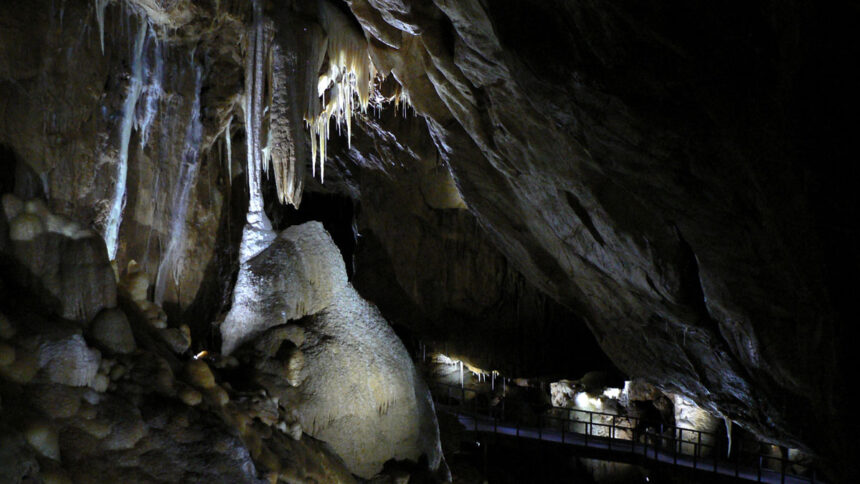
Around 12,900 years ago, as the world was emerging from the last ice age, a sudden, dramatic period of cooling plunged Europe and North America into an icy relapse that lasted 1,300 years. The causes of this event, known as the Younger Dryas, remain elusive. Changes to ocean currents caused by the release of fresh water as ice sheets melted has been proposed as a cause, as has an extraterrestrial impact.
Another hypothesis suggests that cooling was initiated by a large volcanic eruption. A key suspect is the Laacher See Volcano in western Germany, which blanketed much of central Europe with pumice and ash when it erupted around the beginning of the Younger Dryas. The eruption sent plumes of ash 23 kilometers into the stratosphere, scattering sulfate aerosols that would have reflected solar radiation back into space and likely cooled the Northern Hemisphere.
The material ejected from Laacher See is so ubiquitous in Europe that it is commonly used as a time marker in paleontological research. But nailing down the exact date of the eruption has proved challenging, making it difficult to associate the event with the onset of the Younger Dryas. Now, researchers have dated the eruption to 13,008 years ago—roughly 150 years before the cooling period started.
The team of researchers determined this age from speleothems (cave deposits) that, they predicted, should hold in their calcium carbonate makeup a chemical signature of the eruption.
“It’s probably one of the most beautiful volcano signatures in a speleothem that I’m aware of.”
Herbstlabyrinth Cave in western Germany was an ideal place to search for these deposits—“it’s only 70 kilometers away from the volcano, and it was directly in the plume of the eruption,” said coauthor and climate scientist Sophie Warken of Heidelberg University.
After several failed attempts, the team found a stalagmite containing a spike in sulfur in one of the deposit’s growth layers matching the rough timing of the Laacher See eruption. “It’s probably one of the most beautiful volcano signatures in a speleothem that I’m aware of,” said study coauthor Axel Schmitt of Curtin University in Perth, Australia.
Using uranium and thorium concentrations in the material, the researchers narrowed down the date of the eruption to 13,049 years ago, give or take 30 years.
They then looked for sulfur spikes around the same time in ice cores from Greenland. Of seven spikes they found, one fell within the uncertainty of the uranium-thorium date in the stalagmite. The overlap between the uncertainty in these ages, combined with previously published radiocarbon dates obtained from trees buried in the eruption, led the researchers to narrow down the age of the eruption to within 8 years of 13,008 years before present.
By matching the stalagmite and ice core ages, the researchers synchronized the climate chronologies recorded in Europe and Greenland for the Late Glacial Period, something that had previously eluded researchers. That allows scientists to look at the relative timing of climatic events, including the Younger Dryas, between the regions.
By analyzing oxygen isotopes within growth layers of the stalagmite, the team deduced that the eruption preceded cooling in the region by around 150 years. The synchronized records revealed the same for Greenland. The research was published in Science Advances.
Geomorphologist Paul Bierman of the University of Vermont, who has studied the Greenland climate record extensively and who was not involved in the study, called the work “an impressive feat of geochronology,” writing in an email that it provides a “critical linkage” between high- and middle-latitude climate records in the Northern Hemisphere.
Laacher See off the Hook?
Dating the Laacher See eruption to a century and a half before the onset of the Younger Dryas would appear to absolve the volcano of culpability for the cold snap.
However, paleoclimatologist James Baldini of Durham University, who also studies the Laacher See eruption and who was not involved in the study, remained unconvinced. Though he accepted that the new findings may be correct, he said there is also no good reason to discount the dates for the eruption put forward by earlier studies, which put it much closer to the onset of the Younger Dryas.
The new study is “a good effort at a date, and is probably as correct/incorrect as any of the others,” he wrote in an email. “From that perspective it is a welcome addition to the discussion. But just because it’s the most recent date, doesn’t make it the correct one.”
“We’re looking into what happens in ecosystems if very fast climatic changes occur. And for this, we need precise and accurate chronologies.”
Sulfur spikes, he explained, are common in Greenland ice cores, and any calculated date for an eruption will always be relatively close to a sulfur spike. “I don’t think the evidence is strong enough to warrant changing the chronology,” he said.
Even if Laacher See was not responsible for the Younger Dryas, it doesn’t mean another volcano wasn’t. A large sulfur spike seen in the Greenland ice record just before the Younger Dryas suggests that a volcanic eruption may well have triggered the rapid cooling, Baldini said.
Locating that volcano, however, is challenging because evidence for ancient eruptions is often quickly obliterated by sea level rise and subsequent eruptions.
Pinpointing the date of the Laacher See eruption bears on our understanding of current climate change, Warken said. It gives scientists a way to analyze the cause and the regional and global effects of the Younger Dryas, a similar period of relatively rapid climate shifts on Earth, she added. “We’re looking into what happens in ecosystems if very fast climatic changes occur. And for this, we need precise and accurate chronologies.”
—Bill Morris, Science Writer
This news article is included in our ENGAGE resource for educators seeking science news for their classroom lessons. Browse all ENGAGE articles, and share with your fellow educators how you integrated the article into an activity in the comments section below.








